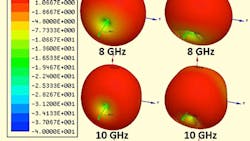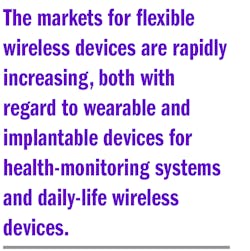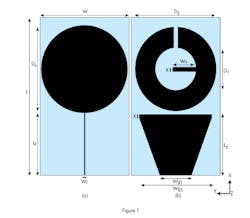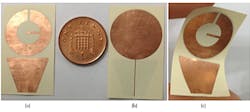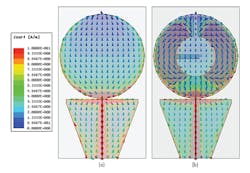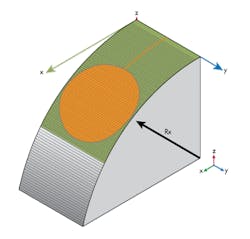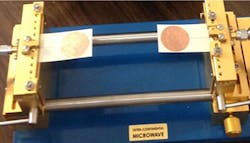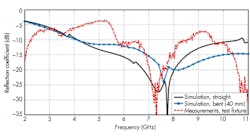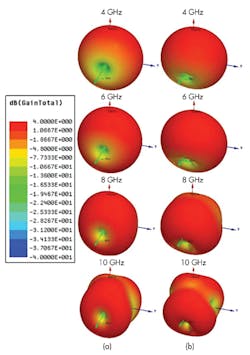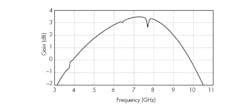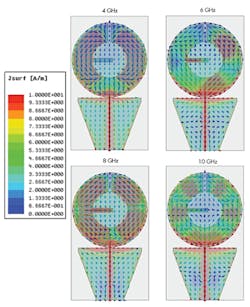This file type includes high resolution graphics and schematics when applicable.
Flexible antennas are important components in a growing number of wireless applications, including wearable electronics and sensor systems. However, flexing the antenna from its nominal straight configuration can impact performance, depending on the antenna design, substrate material, and other factors. To meet the need for flexibility, a robust yet compact ultrawideband (UWB) antenna was designed based on microstrip feed approach.
The antenna design measures just 38 × 22 mm2 and is fabricated on flexible liquid crystalline polymer substrate material. It features a resonating structure, which plays a key role in the enhancement of gain across the lower part of the UWB spectrum. The design was simulated with commercial design software and a prototype was built and characterized, with good agreement between simulations and measurements for bent and straight cases.
The markets for flexible wireless devices are rapidly increasing, both with regard to wearable and implantable devices for health-monitoring systems and daily-life wireless devices (e.g., cell phones, tablets, and laptop computers). For this reason, the need for flexible printed antennas has increased in recent years, especially for biomedical applications,1-3 wearable applications,4, 5 and body-mounted applications.6
A number of flexible antenna designs have been attempted on different mechanically flexible substrate materials. Some approaches involve textile substrates,7, 8 others use paper substrates,9, 10 and still others employ thin, flexible dielectric substrates.11-13 A tradeoff always exists between achieving functional conformability and low cost. In the case of circuits fabricated on flexible substrates, the circuit material must be robust and be able to endure wide temperature ranges without degradation in performance.
For flexible antennas, design goals include good radiation parameters in a compact size, with performance maintained throughout bending. In other words, it is very important requirement that they should perform effectively under various bending conditions.14
One application area in urgent need of flexible devices is UWB communications. The enormous bandwidth available, the capacity for high data rates, and the potential for small size and low processing power—along with low implementation costs—present a unique opportunity for UWB to become a widely adopted radio solution for future wireless home-networking technology.15
Such systems include wireless PC peripherals, multimedia connectivity, and wireless network access for mobile computing devices. One example of a flexible radio application is a body area network (BAN), which is becoming increasingly popular for health monitoring in medical applications.
From a frequency spectrum point of view, UWB technology employs bandwidths of greater than 500 MHz (or fractional bandwidths of greater than 20%15), such as 2,500 to 3,000 MHz. Depending on location, various frequency allocations have been made for UWB series.
Antennas designed for these applications should have reasonable and constant radiation properties (such as radiation pattern type, gain, and polarization) within their operating bandwidths.18, 19 Different planar monopole antenna structures have been widely used as UWB antennas due to their ability to provide constant omnidirectional radiation patterns and controlled input impedance parameters over the UWB frequency band. Moreover, planar antennas have simple structures and small size, and can be printed on the very same PCB circuitry as the transmitter and receiver.20-26
Designing flexible antennas requires thin substrates to accommodate the flexing. As a consequence, the antenna’s radiation pattern properties may be degraded due to the thinness of the substrate. Care must be taken in the design of an antenna with thin substrate material to achieve an omnidirectional radiation pattern with good gain across the target operating frequency range. Examples of UWB flexible antennas in planar configurations are presented in refs. 27-31. Success in achieving good performance parameters has made flexible UWB antennas valuable components for wearable, implantable, and body-centric applications.32-34
By using an extremely thin substrate material, it is possible to develop a compact flexible antenna for UWB applications. The antenna is fed with a microstrip transmission line with modified monopole structure. The design was computer-simulated with a commercial full-wave electromagnetic (EM) simulation software program, with measurements of a prototype matching closely with the performance predictions made by the simulations.
The antenna design employs a microstrip-fed circular monopole with resonator at ground level, fabricated on Ultralam 3850 liquid-crystal-polymer (LCP) circuit material from Rogers Corp. The circuit material has dielectric constant (relative permittivity) of 3.14 in the z-axis (thickness) at 10 GHz with loss tangent of 0.0025. The substrate was 100 µm thick and the copper cladding was 18 µm thick.
Figures 1a and b show the top and bottom design geometry of the antenna, respectively. The top layer is designed as a circular monopole antenna. The monopole antenna is fed by a single 50-⦠transmission line with feed width, Wf = 0.245 mm. To compensate the low efficiency of an antenna fabricated on such a thin substrate, an incomplete half-disk resonator was added on the bottom of the circular patch antenna.
The additional resonator acts as an incomplete reflector, preserving moderate antenna gain without deforming the desired omnidirectional radiation pattern of the antenna. A stub was added to the resonator to compensate for any further added resonance that may affect the desired UWB bandwidth. Finally, the ground shape of the feeding microstrip transmission line was formed in the shape of a triangle to decrease the size of metal at the ends, which enhances bending functionality.
Figure 2 compares the fabricated antenna prototype to a coin (a British penny) and in its bent form. Fabrication was performed by means of a carefully controlled photolithographic process, followed by a high-resolution chemical etching process. As can be seen in Fig. 2c, the antenna’s thin structure and bending capabilities make it an excellent candidate for wearable wireless electronic products.
The initial design of the circular monopole diameter was set equal to the wavelength of the center frequency within the selected UWB bandwidth, which was designed as 7.5 GHz. The antenna was further optimized based on investigating the current flow through the antenna radiator over the full bandwidth of the UWB antenna requirements. The antenna’s dimensions are listed in the table; it has a total area of 38 × 22 mm2.
To explain the role of the additional resonator at ground, the surface current distributions are shown in Fig. 3 with and without the resonator. It shows the direction and distribution of surface currents at 4 GHz induced by the presence of a smaller-radius, ground-resonating structure, which forces the current to coexist more on the edges of the top radiating patch. This enhances the generation of less-deformed radiation patterns at this frequency.
The normalized two-dimensional (2D) gain pattern in the X-Y plane of Fig. 4 demonstrates how the initial structure without the stub resonator improves the generation of radiation in the Z+ direction. It also shows how the addition of the stub results in further enhancements to the radiation pattern in that direction.
The antenna’s performance was simulated with the commercial Ansoft HFSS finite-element EM simulation software from Ansys. Two versions of the antenna were built and simulated: straight and bent forms. Figure 5 shows the configuration of the bent version of the antenna, with the antenna simulated as being bent around an imaginary cylinder with radius of curvature Rx.
The antenna’s resonant characteristics were confirmed by measurements of the fabricated antenna prototype. Figure 6 shows the measurement setup for antenna matching. A test fixture was used to measure antenna impedance-matching properties, since soldering a 50-⦠SMA connector to the antenna for coaxial measurements proved quite difficult due to the narrow width of the antenna’s microstrip transmission lines.
Figure 7 compares the simulated reflection coefficients of the antenna for straight and bent (Rx= 40 mm) formats versus the measured reflection coefficient for the straight antenna. Both simulated results have reflection coefficients lower than −10 dB from 4 to 10.7 GHz. Also, the reflection coefficient is lower than −6 dB within the frequency band of 3 to 4 GHz. Both simulated results display a deep resonance close to 7.5 GHz with small difference in amplitude. Furthermore, the measurements show similar values over most of the frequency band of interest.
The measured reflection coefficient indicates the strong resonance near 7.5 GHz, and is lower than −6 dB at frequencies starting from 3 GHz and higher. However, despite a decrease in the simulated reflection coefficient of less than −10 dB from 4 GHz and higher, the measured reflection coefficient has a sudden increase to −4 dB in the frequency band of 4.0 to 5.3 GHz before it decreases to less than −10 dB, preserving a pattern close to that of the simulated curves.
This is caused by the difficulty in making measurements due to the thin feeding microstrip line width. However, it is still apparent that the measurement and simulated results are fairly close.
To validate the antenna’s far-field characteristics, three-dimensional (3D) gain radiation patterns were simulated at certain frequencies (4, 6, 8, and 10 GHz), as shown in Fig. 8. To validate that bending the antenna does not affect its radiation patterns, the simulated radiation patterns for the straight antenna (Fig. 8a) are compared to the bent antenna with Rx = 40 mm for the same selected frequencies (Fig. 8b). In both cases, the 3D gain patterns preserve an omnidirectional pattern , as is quite apparent at 4, 6, and 8 GHz. A small deformation in the omnidirectional pattern is noticeable at 10 GHz.
By observing the color bar of the plotted pattern, the antenna has directive gain values that range around −40 dB for nulls at x axis (feeding axis) and 4 dB for boresight direction. For more antenna radiation pattern investigation, the simulated antenna gain at the Z axis is plotted in Fig. 9. As can be seen, the antenna gain reaches a maximum at 7 GHz, where it is 3.5 dB, and a minimum at −1 dB for the frequency band edges within the UWB spectrum.
To analyze the antenna radiation patterns within the UWB frequency range, the current distributions were measured and plotted for the same test frequencies at 4, 6, 8, and 10 GHz (Fig. 10). As can be seen, the radiation pattern degrades with increasing frequency. Also, the current distribution is homogenous over the antenna’s resonant band in ordered harmonics, which explains how the antenna preserves the omnidirectional pattern at these frequencies.
The antenna design provides near-stable performance with bending in terms of matching and radiation characteristics. The design appears suitable for use in wearable applications, although other issues must also be considered. These include the specific absorption rate (SAR), along with the thermal and dielectric properties of the substrate material when matched with human tissue for medical applications.
In short, the antenna design combines flexibility with a miniature footprint of only 38 × 22 mm2, making it a good fit (literally) for wearable wireless applications. It is designed for use in the upper UWB frequency range from 4 to 10.6 GHz, satisfying at least 82% of the FCC’s UWB frequency regulation and 100% of the ECC’s DS-UWB frequency-range requirements. The antenna maintains an omnidirectional radiation pattern in both straight and bent configurations except at higher frequencies, with high gain throughout.
Sherif R. Zahran, Postgraduate Student
Arab Academy for Science and Technology, Department of Electronics Engineering, Cairo, Egypt
Mahmoud A. Abdalla, Professor
Electromagnetic Waves Group, Department of Electronic Engineering, Military Technical College, Cairo, Egypt
A. Gaafar, Associate Professor
Arab Academy for Science and Technology, Department of Electronics Engineering, Cairo, Egypt
References
1. Peter S. Hall and Yang Hao, Antennas and Propagation for Body-Centric Wireless Communications, Second Edition, Artech House, Norwood, MA, 2011.
2. Haider R. Raad, Ayman I. Abbosh, Hussain M. Al-Rizzo, and Daniel G. Rucker, “Flexible and Compact AMC Based Antenna for Telemedicine Applications,” IEEE Transactions on Antennas and Propagation, Vol. 61, No. 2, 2013, pp. 524-531.
3. Maria Lucia Scarpello, Divya Kurup, Hendrik Rogier, Dries Vande Ginste, Fabrice Axisa, Jan Vanfleteren, Wout Joseph, Luc Martens, and Gunter Vermeeren, “Design of an Implantable Slot Dipole Conformal Flexible Antenna for Biomedical Applications,” IEEE Transactions on Antennas and Propagation, Vol. 59, No. 10, 2011, pp. 3,556-3,564.
4. Yei Hwan Jung, Yijie Qiu, Subin Lee, Ting-Yen Shih, and Yuehang Xu, “A Compact Parylene-Coated WLAN Flexible Antenna for Implantable Electronics,” IEEE Antennas and Wireless Propagation Letters, Vol. 15, 2016, pp. 1,382-1385.
5. Haider Raad Khaleel, “Design and fabrication of compact inkjet printed antennas for integration within flexible and wearable electronics,” IEEE Transactions on Components, Packaging, and Manufacturing Technology, Vol. 4, No. 10, 2014, pp. 1,722-1,728.
6. Seungman Hong, Seok Hyon Kang, Youngsung Kim, and Chang Won Jung, “Transparent and Flexible Antenna for Wearable Glasses Applications,” IEEE Transactions on Antennas & Propagation, Vol. 64, No. 7, 2016, pp. 2,797-2,804.
7. William G. Whittow, Alford Chauraya, J.C. Vardaxoglou, Yi Li, Russel Torah, Kai Yang, Steve Beeby, and John Tudor, “Inkjet-Printed Microstrip Patch Antennas Realized on Textile for Wearable Applications,” IEEE Antennas and Wireless Propagation Letters, Vol. 13, 2014, pp. 71-74.
8. Asimina Kiourti, Cedric Lee, and John L. Volakis, “Fabrication of Textile Antennas and Circuits with 0.1 mm Precision,” IEEE Antennas and Wireless Propagation Letters, Vol. 15, 2016, pp. 151-153.
9. Ting Leng, Xianjun Huang, KuoHsin Chang, JiaCing Chen, Mahmoud A. Abdalla, and Zhirun Hu, “Graphene Nanoflakes Printed Flexible Meandered-Line Dipole Antenna on Paper Substrate for Low-Cost RFID and Sensing Applications,” IEEE Antennas and Wireless Propagation Letters, Vol. 15, 2016, pp. 1,565-1,568.
10. Hattan F. Abutarboush, M.F. Farooqui, and A. Shamim, “Inkjet-Printed Wideband Antenna on Resin-Coated Paper Substrate for Curved Wireless Devices,” IEEE Antennas and Wireless Propagation Letters, Vol. 15, 2016, pp. 20-23.
11. Sana Ahmed, Farooq A. Tahir, A. Shamim, and Hammad M. Cheema, “A Compact Kapton-Based Inkjet-Printed Multiband Antenna for Flexible Wireless Devices,” IEEE Antennas and Wireless Propagation Letters, Vol. 14, 2015, pp. 1,802-1,805.
12. Z. Hamouda, J. -L. Wojkiewicz, A.A. Pud, L. Kone, B. Belaabed, S. Bergheul, and T. Lasri, “Dual-Band Elliptical Planar Conductive Polymer Antenna Printed on a Flexible Substrate,” IEEE Transactions on Antennas & Propagation, Vol. 63, No. 12, 2015, pp. 5,864-5867.
13. K. Janeczek, M. Jakubowska, G. Koziol, A. Mlozniak, and A. Arazna, “Investigation of ultra-high-frequency antennas printed with polymer pastes on flexible substrates,” IET Microwaves, Antennas & Propagation, Vol. 6, No. 5, 2012, pp. 594-554.
14. Hsuan-Ling Kao, Cheng-Lin Cho, Xiu Yin Zhang, Li-Chun Chang, Bai-Hong Wei, Xin Dai, and Hsien-Chin Chiu, “Bending Effect of an Inkjet-Printed Series-Fed Two-Dipole Antenna on a Liquid Crystal Polymer Substrate,” IEEE Antennas and Wireless Propagation Letters, Vol. 13, 2014, pp. 1,172-1,175.
15. Homayoun Nikookar and Ramjee Prasad, Introduction to UltraWideband for Wireless Communications, Chapter 2, Springer Science & Business Media, New York, 2008.
16. Federal Communications Commission, “Revision of Part 15 of the Commission’s rules regarding ultra-wideband transmission system from 3.1 to 10.6 GHz,” ET-Docket, Federal Communications Commission, FCC, 98-153, Washington, DC, 2002.
17. Report from CEPT to the European Commission in response to the Fifth Mandate to CEPT on ultra-wideband technology to clarify the technical parameters in view of a potential update of Commission Decision 2007/131.
18. Ian Oppermann, Matti Hämäläinen, and Jari Iinatti, UWB: Theory and Applications, John Wiley & Sons, New York, 2005.
19. Zhi Ning Chen and Michael Yan Wah Chia, Broad Band Planer Antennas: Design and Applications, Chapter 2, John Wiley & Sons, New York, 2006.
20. Y. Lu, Y. Huang, H.T. Chattha, and P. Cao, “Reducing ground-plane effects on UWB monopole antennas,” IEEE Antennas and Wireless Propagation Letters, Vol. 10, 2011, pp. 147-150.
21. Sherif R. Zahran, Omar H. El Sayed Ahmed, Ahmad T. El-Shalakany, Sherif S. Saleh, and Mahmoud A. Abdalla, “Ultra Wide Band Antenna with Enhancement Efficiency For High Speed Communications,” NRSC 2014, Cairo, Egypt, pp. 65-72.
22. Ahmed Abdelreheem and Mahmoud Abdalla, “Compact Curved Half Circular Disc-Monopole UWB Antenna,” International Journal of Microwave and Wireless Technologies, Vol. 8, No. 2, 2016, pp. 283-290.
23. Ahmed Adelraheem, Mahmoud Abdalla, Hesham Elregaily, and Abdelazez Mitkees, “Experimental Evaluation of High-Fidelity High-Data-Rate UWB Antenna System,” 2015 IEEE AP-S International Antenna and Propagation Symposium Digest, July 2015, Vancouver, Canada, pp. 522-523.
24. Mohamed Nabil Srifi, Symon K. Podilchak, Mohamed Essaaidi, and Yahia M.M. Antar, “Compact Disc Monopole Antennas for Current and Future Ultrawideband (UWB) Applications,” IEEE Transactions on Antennas and Propagation, Vol. 59, No. 12, 2011, pp. 4,470-4,480.
25. Mahmoud A. Abdalla, Ahmed A. Ibrahim, and Ahmed Boutejdar, “Resonator Switching Techniques for Notched UWB Antenna in Wireless Applications,” IET Microwaves, Antennas & Propagation, Vol. 9, No. 13, 2015, pp. 1468-1477.
26. Ahmed A. Ibrahim, Mahmoud A. Abdalla, and Ahmed Boutejdar, “Hybrid Technique Delivers Dual-Notch UWB antenna,” Microwaves & RF, Vol. 55, No. 5, May 2016, pp. 56-60.
27. A.C. Durgun, M.S. Reese, C.A. Balanis, C.R. Birtcher, D.R. Allee, and S. Venugopal, “Design, simulation, fabrication and testing of flexible bow-tie antennas,” IEEE Transactions on Antennas & Propagation, Vol. 59, No. 12, December 2011, pp. 4,425-4,435.
28. Haider R Khaleel., Hussain M. Al-Rizzo, Daniel G. Rucker, and Seshadri Mohan, “A compact polyimide-based UWB antenna for flexible electronics,” IEEE Antennas and Wireless Propagation Letters, Vol. 11, 2012, pp. 564-567.
29. Sherif R. Zahran and Mahmoud Abdalla, “Novel Flexible Antenna for UWB Applications,” 2015 IEEE AP-S International Antenna and Propagation Symposium Digest, July 2015, Vancouver, Canada, pp. 147-148.
30. H.K. Yoon, Y.J. Yoon, H. Kim, and C-H. Lee, “Flexible ultra-wideband polarisation diversity antenna with band-notch function,” IET Microwaves, Antennas & Propagation, Vol. 5, No. 12, 2011, pp. 1,463-1,470.
31. Qammer H. Abbasi, Masood Ur Rehman, Xiaodong Yang, Akram Alomainy, Khalid Qaraqe, and Erchin Serpedin, “Ultrawideband band-notched flexible antenna for wearable applications,” IEEE Antennas and Wireless Propagation Letters, Vol. 12, 2013, pp. 1,606-1,609.
32. Yijie Qiu, Yei Hwan Jung, Subin Lee, Ting-Yen Shih, Juhwan Lee, Yue Hang Xu, Ruimin Xu, Weigan Lin, Nader Behdad, and Zhenqiang Ma, “Compact parylene-c-coated flexible antenna for WLAN and upper-band UWB applications,” Electronics Letters, Vol. 50, No. 24, 2014, pp. 1,782-1,784.
33. Hadi Bahrami, S. Abdollah Mirbozorgi, Reza Ameli, Leslie A. Rusch, and Benoit Gosselin, “Flexible, Polarization-Diverse UWB Antennas for Implantable Neural Recording Systems,” IEEE Transactions on Biomedical Circuits & Systems, Vol. 10, No. 1, 2016, pp. 38-48.
34. Yiye Sun, Sing Wai Cheung, and Tung Ip Yuk. “Design of a textile ultra-wideband antenna with stable performance for body-centric wireless communications,” IET Microwaves, Antennas & Propagation, Vol. 8, No. 15, 2014, pp. 1,363-1,375.
This file type includes high resolution graphics and schematics when applicable.
